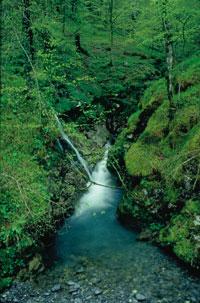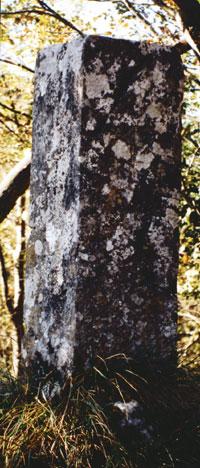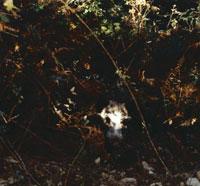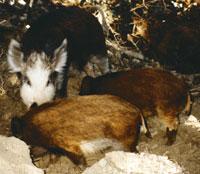King of Murumendi: Boar

The region known as Murumendi is located in the center of Gipuzkoa. The boundaries and areas corresponding to this area extend along four municipalities whose ownership and management is in charge of the Municipalities of Beasain, Itsasondo, Bidegoian and Beitzama. Also, within the limits of Murumendi, the boundaries of these four municipalities are grouped in an area where they are separated by a mojón. This area is called Domiko and it is a milestone of carved and elegant stone.
The height of Murumendi, 887 meters high, boasts of imposing itself on the mountains and hills of the area: Maramendi (708 m), Basagain (652 m), Zarate (651 m) and Oterre (680 m), to name a few.
At the top of Murumendi, meanwhile, there is a separation and separation between the Urola and Oria rivers and their water networks. The Cantabrian Sea is accessed from two different points: Urola, Zumaia and Oria, from Orio.
This medium has an oceanic climate and is located in the Atlantic area of the Eurosiberian region. Therefore, rainfall is frequent throughout the year and humidity is its main characteristic. Although temperatures are relatively low, the difference between winter and summer temperatures is very different.

The height of the mountains in this area ranges from 600 to 800 meters in most cases. In this sense, and taking into account the aforementioned climatic conditions, we find that the territory is very appropriate for wide leaf trees. In these lands predominate the different types of native forests such as beech, mixed or oak forests. Among the trees in the mixed forests are chestnut (Castanea sativa), gold (Corylus avellana), oak (Quercus robur) and beech (Fagus sylvatica).
As we said at the beginning, the man who has lived in these places has used the earth to earn his living. On the one hand, he has been a farmer, locating and expanding agricultural areas around the hamlets. On the other hand, it has also acted as a farmer and the signs and traces of the influence of livestock are very noticeable throughout the environment, for example, in some areas the meadows replace the original forests.

However, over time, the man has left the hamlets and went down to the street to work there. And gradually the hamlets have emptied, abandoned. To the same extent that they were emptying, of course, the use of these lands has changed radically and the farmer has planted his forests with allochthonous trees. This type of forest is called non-climatic, as it is produced by extracting non-native trees and planting foreign species. You don't have to go too far to find a clear example of this, since the case of Intsinis radiata pine is well known among us.
Geologically the substrate of this area is cretaceous. Biostromatic calyx, margolimestone, fine-grained calyx and calcareous argilites, along with sandstone and argilites.
King of Murumendi
All the above mentioned and listed requirements can lead to a concrete conclusion: Murumendi is the ideal residence for the wild boar, pioneer of the pig, of the Suidos family Sus scrofa castilanus, Murumendi. It is the largest wild mammal in the area. It is local, spectacular and large, which has allowed to create a certain fascination between the inhabitants of the hamlets and neighborhoods of the area.
Undoubtedly, the relationship between Murumendi's boar and man is very curious. On the one hand, to the extent that man is a hunter, we can say that he is the “natural” enemy of the boar: Murumendi and the boar have become a good place for hunting; this has been done previously and continues to be practiced. On the other hand, boars grow in some hamlets as if they were pigs and in some cases they have been introduced into the hamlets of the area mixing or hybridizing them with pigs.

This animal highlights sexual dimorphism, which means that males and females are not exactly the same. In these latitudes this phenomenon is more spectacular: while the male can reach 150 kilos, the female barely reaches 90 kilos. Latitude is a decisive element: as it rises, wild boars grow and, for example, in the Carpathians there have been samples of 350 kilos.
As for its physical appearance, it is also evident the distinction between sexes, with the longest end of the female and the disappearance of the canines. The male, on the other hand, has large canines, although its end is smaller. As they grow, canines also increase.

Boar is onmiboro and can eat almost anything you find in the forest. Optionally, chestnuts and acorns are preferred. With the same luck, during autumn nights, you can see readers, in small groups or individually, eating around the chestnut trees and oak trees of the mountains. Nor is it opposed to the roots, tubers or truffles of some plants.
Even oddly, he also eats meat. The diet is very varied and in its daily menu appear small mammals, amphibians or reptiles. Vipers are also highly appreciated for wild boars and are well prepared for capture with special techniques. In his opinion, this generates strong demographic pressure on the viper population. The populations of vipers and wild boars are therefore inversely proportional, and in regions where the king of Murumendi is abundant, snakes will hardly live.

Many things have been said about the boar, many of them supposed. Ignorance suggests that boar is a wild and dirty animal. However, studies show that boar pays great attention to its appearance: it strives to keep clean skin and shiny hair and with mud baths that are very beneficial. These baths, in addition to being a good system of elimination of parasites that stick to the skin, offer a simple way to maintain the skin and appearance of the hair. Animal pimpirina! You will not choose any well or mud for your bathroom and if you choose the one that suits you, you will also travel eleven kilometers to reach the suitable well. We are surprised by this custom and give the boar an afternoon look because it takes mud baths, which in our society are becoming more frequent and help keep the skin soft and beautiful.
At the time of zeal, in December, males fight for the female and not all kinds of programs. As always, the strongest will be defeated by the enemies and will cover the female. The young were born around May or April. Young females usually have fewer wild boars, 2 or 4, and as they age, the breeding will be higher.

Although boar is an aggressive and dangerous animal, we have heard many times. That is another baseless topic. In fact, the king of Murumendi, frightened and fugitive, tends to hide only warning of any danger. But it will not be taken: if it does not find escape, it will not immediately cede or be immobile. He will not refuse to fight and then he is very dangerous our friend.
Fortunately, boar is not in danger of extinction. Its reproductive ease, comfort and ability to adapt to its environment allow us to affirm that the boar population is balanced, despite the strong hunting pressure. Murumendi is a place of hiding, food and reproduction in which the boar is served well. In addition, there are no predators that attack you in the place, and thus live with ease and comfort in the area. The only one who can endanger the life of the king of Murumendi is the man, and if he is afraid of someone he will have to be afraid.





